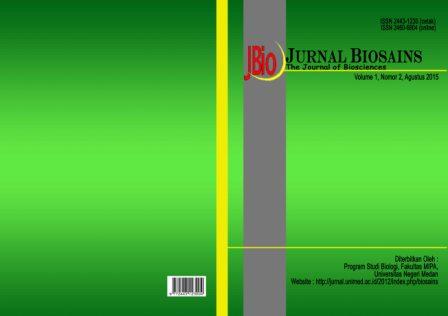Apoptosis Sel-sel Spermatogenik Tikus Putih (Rattus norvegicus) Akibat Pajanan Plumbum (Pb)Serta Perbaikannya Setelah Pemberian Kitosan
DOI:
https://doi.org/10.24114/jbio.v1i2.2784Abstract
Programmed cell death (apoptosis) of white rat spermatogenic cells can be caused by several factors, including heavy metals such as Cu, Au, Hg, Cd and Pb. The heavy metals found in industrial environments and some public places such as highways and oil pump. This study aims to reduce the negative effects of Pb by using chitosan obtained from shrimp shell processing of the garbage discarded in some shrimp producing areas. This study is divided into six treatment groups K1 = control; K2 = Pb; P1 = Pb+chitosan 0.5%; P2 = Pb = 0.75% chitosan, P3 = Pb+chitosan 1%, P4 = Pb+chitosan 1%. The results showed that administration of Pb causes apoptosis in spermatogenic cells (spermatogonia 78.26%; 84.7% spermatocytes, 77.1% spermatocytes). The addition of 1% chitosan is the best fix apoptotic spermatogenic cells after administration of Pb (Plumbum acetate). Keywords: apoptosis, cells spermatogenic, plumbum, chitosan.Downloads
Issue
Section
License
For Authors Jurnal Biosains agree to the following terms:
Authors retain copyright and grant the Jurnal Biosains (JBIO) right of first publication with the work simultaneously licensed under a Creative Commons Attribution License (CC BY-SA 4.0) that allows others to share (copy and redistribute the material in any medium or format) and adapt (remix, transform, and build upon the material) the work for any purpose, even commercially with an acknowledgement of the work's authorship and initial publication in JBIO (Jurnal Biosains)
Authors are able to enter into separate, additional contractual arrangements for the non-exclusive distribution of the journal's published version of the work (e.g., post it to an institutional repository or publish it in a book), with an acknowledgement of its initial publication in JBIO (Jurnal Biosains)
Authors are permitted and encouraged to post their work online (e.g., in institutional repositories or on their website) prior to and during the submission process, as it can lead to productive exchanges, as well as earlier and greater citation of published work (See The Effect of Open Access).


